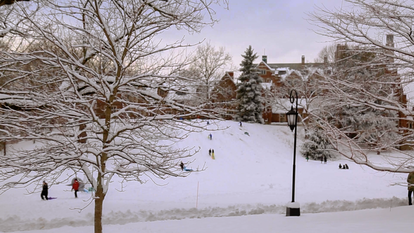An American Turkey and Her Brood Join the Wellesley Community

Wellesley’s diverse natural resources attract many species of wildlife, including white-tailed deer, mute swans, cottontail rabbits, red foxes, muskrats, and American turkeys. The female turkey pictured here was spotted recently with her brood near the Academic Quad.
The College’s bucolic landscape, with its trees and shrubs, seems like it could be a wonderful environment for these birds, said Nicholas Rodenhouse, professor of biological sciences. Female turkeys nest on the ground among dead leaves, typically at the base of a tree or under a thick shrub. Their clutch size can range from four to 17 eggs, and incubation lasts from 25 to 31 days, with longer periods during cooler weather. (This female’s clutch contained seven eggs.)
Once the chicks hatch, typically all on one day, the mother will lead them to areas where food is available and guard them as they forage. Young and old alike are omnivorous and scratch in the leaf litter to reveal bugs and seeds.
“Turkeys have thrived in suburban areas that cannot sustain many species of songbirds because a mother turkey is an imposing presence, well able to protect her chicks from predators, such as domestic or feral cats, that often kill fledgling songbirds,” said Rodenhouse.
When the young are old enough to fly, they roost at night on a low horizontal tree limb with their mother. A running start and lots of flapping are needed to get these inexperienced birds aloft.
Turkeys travel as a family group, and often multiple groups will combine, creating a flock of young turkeys accompanied by several adult females. (Male turkeys are not involved with caring for the young.)



